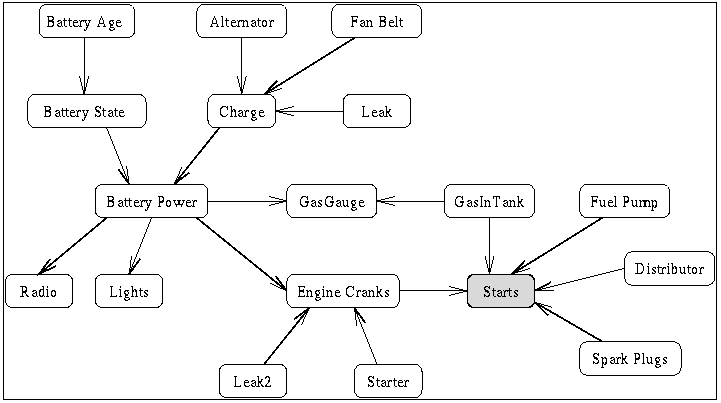
In this assignment you will implement tell and
ask for belief networks using the SPI algorithm developed
at OSU by Professor D'Ambrosio and his former student Dr. Zhao-yu Li.
I have already implemented the basic operations on probability tables,
and I've provided a skeleton implementation for the operations on
belief networks. You should download these from the file belief-net.lisp and modify
the file to complete the assignment. To use this file, you should
start up your lisp and load the aima.lisp file. This
will load the necessary utilities. Then you can load your modified
version of belief-net.lisp. Once you have your code
working, you should compile it.
class belief-net. A belief network is essentially a list of
conditional probability tables (known as ptables in the
file). Here is the definition of belief-net:
(defstructure (belief-net (:constructor create-belief-net)) (nodes nil) ; a list of ptable's (known-variables nil) ; variables whose values have been tell'ed (known-values nil) ; alist of known variables and values (variables nil)) ; all variables in the networkThe function
make-belief-net will create a belief
network. It takes as argument a list with the format shown in the
following example:
(defparameter *test-net*
'((cloudy
((cloudy)
.5 ; f
.5 ; t
))
(sprinkler
((sprinkler cloudy)
.5 ; f f
.9 ; f t
.5 ; t f
.1 ; t t
))
(rain
((rain cloudy)
.8 ; f f
.2 ; f t
.2 ; t f
.8 ; t t
))
(wet-grass
((wet-grass rain sprinkler)
1.0 ; f f f
0.1 ; f f t
0.1 ; f t f
0.01 ; f t t
0.0 ; t f f
0.9 ; t f t
0.9 ; t t f
0.99 ; t t t
))))
The format is (node1 node2 ... ) .node has the format (variable cpt-info)variable is a symbol giving the name of the node's
variable.cpt-info is a list suitable for passing
to make-ptable. It has the following format(var-list p000 ... p111)where
var-list is a list of the variables that appear in
this table and p000 ... p111 are the probability values
that will appear in the table.
The order in which the nodes appear is very important because it
determines the order in which the probability values are interpreted.
Specifically, if the node for variable a is defined
before the node for variable b, then in any
ptable, the value of a will be varied faster
than the value of b. For example, in the last table
shown above, the variable sprinkler is varied the fastest
(i.e., it is like the least-significant bit in the table), and the
variable wet-grass is varied the slowest. I suggest that
you list the nodes in "causal order" (e.g., sprinkler,
rain, and wet-grass) and then, within each
ptable, list the nodes in reverse causal order (e.g., wet-grass
rain sprinkler).
Debugging. Your implementation should be able to reproduce the following trace:
;; create the network > (setq *net* (make-belief-net *test-net*)) ;; make a copy that we will destroy via tell and ask > (setq *bn* (deep-copy-belief-net *net*)) > (ask *bn* 'rain) (RAIN) Probability 0 0.5000 1 0.5000 > (tell *bn* 'wet-grass 1) > (ask *bn* 'rain) (RAIN) Probability 0 0.2921 1 0.7079 ;; note that if we ask about something we have already told it, we ;; should get an answer back. > (ask *bn* 'wet-grass) 1 > (tell *bn* 'cloudy 0) > (ask *bn* 'rain) (RAIN) Probability 0 0.6557 1 0.3443 > (tell *bn* 'sprinkler 0) > (ask *bn* 'rain) (RAIN) Probability 0 0.0000 1 1.0000 >To aid in your debugging, here is the joint distribution for the *test-net*:
(WET-GRASS RAIN SPRINKLER CLOUDY) Probability 0000 0.2000 0001 0.0900 0010 0.0200 0011 0.0010 0100 0.0050 0101 0.0360 0110 0.0005 0111 0.0004 1000 0.0000 1001 0.0000 1010 0.1800 1011 0.0090 1100 0.0450 1101 0.3240 1110 0.0495 1111 0.0396
Test problem. The file also contains a network for diagnosing
problems with cars. The variable *car-net* describes
the following belief network:

Note that in this network, a value of 0 is the "good" value, and a value of 1 indicates a problem. Your assignment is to compute the probability of each of the following causes after each observation. The possible causes are the following:
SparkPlugs Distributor FuelPump Leak2 Starter BatteryAge Alternator FanBelt Leak GasInTank
Starts is 1. (car won't start)
EngineCranks is 1. (engine won't crank)
GasGauge is 1. (gas gauge reads empty)
Radio is 1. (radio doesn't work)
FuelPump is 0. (fuel pump ok)